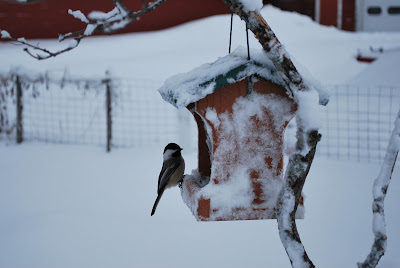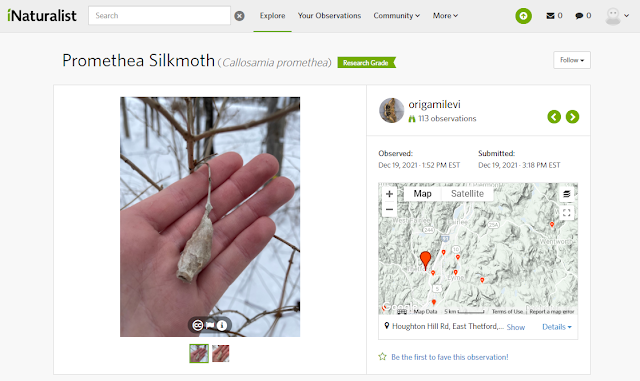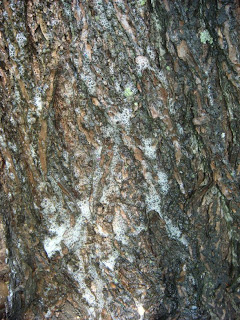Get Wild this Winter with iNaturalist, eBird, and VT Atlas of Life
 |
| A chickadee eats from a snowy feeder at Knight Point. |
Not sure where to start? Scroll down for a breakdown of the differences between iNaturalist, eBird, and the Vermont Atlas of Life.
iNaturalist
 |
| An entry for a Promethea Silkmouth as viewed on iNaturalist's desktop view. |
What is it? iNaturalist is “a community of over a million scientists and naturalists who can help you learn more about nature" and the information is used to help scientists study and protect nature.
What can I do? iNaturalist allows users to post images or audio clips with notes for sightings. Any user can comment and suggest identifications. Sightings are ranked with varying degrees of certainty from casual to ‘expert’. You can talk with other users to discuss sightings across species on everything from fungi to reptiles to plants. All sightings from around the world are easily searchable!
How to access? Desktop computer at https://www.inaturalist.org/ or download through an app store on a mobile device.
Recent sightings: Snowshoe hare tracks, a Promethea Silkmoth cocoon, a pair of Snow Buntings
eBird
 |
| You can search eBird by location to find most recent sightings, top recent images, rare birds spotted and more. |
What can I do? eBird allows users to post images and audio recordings for strictly bird sightings. This program excels at creating lists of birds you have seen (and hope to see in the future) and share your sighting lists with others.
Need a little help on that bird identification? Get a little help from the Cornell Lab of Ornithology’s Merlin mobile app for on-the-go bird identification help. By answering a few questions, Merlin can give you a list of likely birds based on your observations.
How to access? Desktop computer at https://ebird.org/ or download through an app store on a mobile device.
Recent sightings: Iceland Gull, Snowy Owl, Yellow-bellied Sapsucker
The Vermont Atlas of Life
What is it? The Vermont Center for Ecostudies' Vermont Atlas of Life is a "central library of knowledge on the biodiversity of Vermont: animals, plants, and fungi." This community science project compiles information from over 6 million sightings from the group’s projects on iNaturalist, eBird, and eButterfly.
What can I do? You can view the database of over 6 million records or add you own through the group’s projects on iNaturalist, eBird, and eButterfly.
How to access? Head to the main page for the database and project links at https://val.vtecostudies.org/.
Note: Ok, you got us we already talked about iNaturalist and eBird, but Vermont Atlas of Life is a project you don’t want to miss! They manage the Vermont projects for each of the groups listed above and do a great job using that information to help conserve and protect our wild neighbors.
Have any images or videos of your wildlife adventures in Vermont State Parks? Make sure to share them to our Facebook, Instagram, or Twitter accounts with #vtstateparks and it could be featured for a #WildlifeWednesday post! What is your best winter wildlife sighting? Share in the comments below!


.jpg)
.jpg)
Comments
Post a Comment
Feel free to let us know what you think.